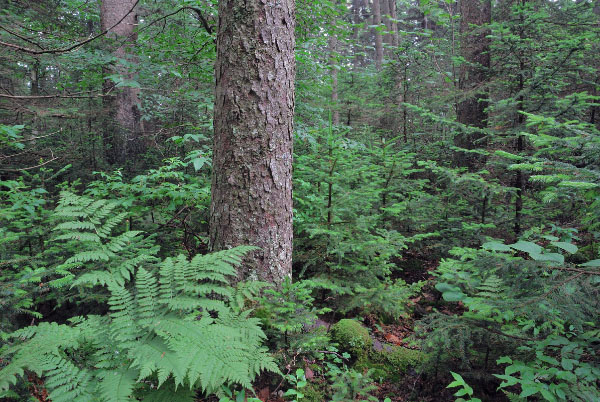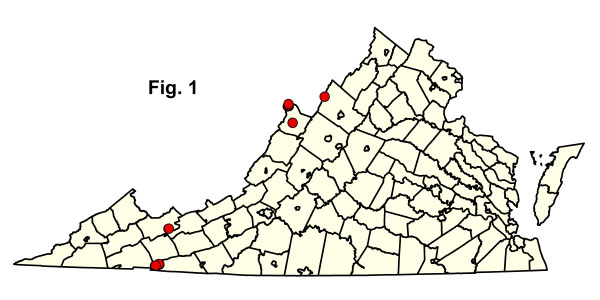

Virginia Department of Conservation and RecreationAn official website of the Commonwealth of Virginia Here's how you knowAn official websiteHere's how you know

Virginia Department of Conservation and RecreationAn official website of the Commonwealth of Virginia Here's how you knowAn official websiteHere's how you know
 Department of Conservation and Recreation
Department of Conservation and Recreation
 Table of Contents
Table of ContentsSpruce and Fir Forests
Communities of this group are characterized by coniferous and mixed forests with overstory dominance by red spruce (Picea rubens) or Fraser fir (Abies fraseri). Similar forests occur in the Appalachians from West Virginia south to western North Carolina and eastern Tennessee.
Fraser fir forests reach their northern range limit in southwestern Virginia, where they are confined to elevations above 1,700 m (5,400 ft) on Mount Rogers in Grayson and Smyth Counties. Habitats are characterized by extremely acidic, organic-rich soils; cold microclimates; high rainfall; frequent fogs; and lush bryophyte cover. Understory layers are sparse, while mountain wood fern (Dryopteris campyloptera) and mountain wood-sorrel (Oxalis montana) dominate a relatively dense herb layer. Near the lower elevation limits, mixtures of Fraser fir and red spruce are characteristic. Fraser fir-dominated vegetation is seriously threatened by air pollution and destruction of fir stands by the balsam woolly adelgid (Adelges piceae), an introduced insect pest.
Red spruce (Picea rubens) forests similar in composition to those of the North Carolina and Tennessee high mountains are restricted to high-elevation slopes and summits of the Southern Blue Ridge (> 1,300 m [4,300 ft]) in Grayson, Smyth, and Washington Counties and Clinch Mountain (> 1,400 m [4,600 ft]) in Russell and Tazewell Counties. Environmental conditions are similar to those of the Fraser fir forests. Southern mountain-cranberry (Vaccinium erythrocarpum) and hobblebush (Viburnum lantanoides) are prevalent shrubs in the typical stands of these communities. A rarer community type features overwhelming shrub dominance by evergreen rhododendrons (Rhododendron maximum and Rhododendron catawbiense). Yellow blue-bead lily (Clintonia borealis), mountain wood fern (Dryopteris campyloptera), mountain wood-sorrel (Oxalis montana), shining clubmoss (Huperzia lucidula), and Canada mayflower (Maianthemum canadense) are abundant herbs rooting in the thick moss cover. As lower elevation limits are approached, co-dominance by hardwoods, particularly yellow birch (Betula alleghaniensis), increases.
Red spruce forests and spruce-hardwood mixtures also occur locally at high elevations of Allegheny Mountain (above 1,100 m [3,600 ft]) and Jack Mountain (above 1,280 m [4,200 ft]) in Highland County, but differ considerably from the Southern Blue Ridge and Clinch Mountain stands. At least two compositional variants, associated with submesic ridge crests and mesic stream-head valleys, are present on Allegheny Mountain. Distinctly southern species are nearly lacking from these forests, while northern species such as late lowbush blueberry (Vaccinium angustifolium), stiff ground-pine (Spinulum annotinum), prickly tree-clubmoss (Dendrolycopodium dendroideum), and staghorn clubmoss (Lycopodium clavatum), are abundant.

Due to their restricted geographic and elevation ranges, all community types in this ecological group are considered globally rare. Red spruce forests provide Virginia's only viable habitats for the northern flying squirrel (Glaucomys sabrinus fuscus), a federally and state-listed endangered species. Other animals of global or state significance associated with spruce and fir forests include pigmy salamander (Desmognathus wrighti), Weller's salamander (Plethodon welleri), and the state-endangered snowshoe hare (Lepus americanus virginianus). A number of northern birds, including the northern saw-whet owl (Aegolius acadicus), hermit thrush (Catharus guttatus), magnolia warbler (Setophaga magnolia), golden-crowned kinglet (Regulus satrapa), red-breasted nuthatch (Sitta canadensis), and winter wren (Troglodytes troglodytes), rely on high-elevation coniferous forests for breeding in Virginia.
References: Adams (1991), Bailey and Ware (1990), Fleming and Coulling (2001), Fleming and Moorhead (1996), McLaughlin et al. (1987), Pielke (1981), Rawinski et al. (1994), Rheinhardt and Ware (1984), Smith and Nicholas (1999), Stephenson and Adams (1984), Stevens (1969).
Click here for more photos of this ecological community group.
 © DCR-DNH, Gary P. Fleming.
© DCR-DNH, Gary P. Fleming.

 Download a spreadsheet of compositional summary statistics (Excel) for each of the community types listed below.
Download a spreadsheet of compositional summary statistics (Excel) for each of the community types listed below.

